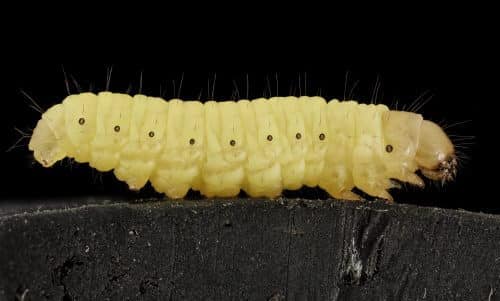The scientific curiosity of an amateur beekeeper from Spain and the unique ability of wax worms may help to find a solution to the problem of handling plastic waste.

By: Ofir Marom
When Dr. Federica Bertuccini is not doing research in her laboratory at the research institute in Santander, Spain, she is tending to her beehives. One day, while taking care of her hives, Dr. Bertuccini discovered worms in them, called waxworms. These worms are harmful, because they eat the beeswax, the dung from which the hive is built, thus effectively destroying it. Dr. Bertuccini collected the worms, placed them in a plastic bag and continued to treat the rest of the hives. When she returned to the bag she found it empty and full of holes. The wax worms ate their way to freedom through the bag. Instead of getting angry, she marveled at the speed with which the worms dealt with the plastic the bag was made of.
Dr. Bertuccini, a researcher in the field of fetal development and is not an expert on insects or plastics, but the scientific question that arose before her eyes was too big and too important for her to ignore. Are the wax worms a solution for rapid decomposition of plastic?
The reason plastic is such a successful packaging material is also why it is such a serious environmental pollutant. The different types of plastic are very resistant to biological decomposition. Bacteria, fungi, and other organisms, which in nature are responsible for the last step of breaking down organic materials into the basic building blocks, are unable to deal with the chemical structure of plastic. Therefore, where plastic is found, it will usually remain for many years.
Other scientists have already discovered different organisms that do a similar action. Last year, a Japanese team identified a new strain of bacteria that can break down PET plastic. In 2014, Chinese scientists found that working together two species of bacteria, originating from the guts of a different type of wax caterpillar, can break down polyethylene (PE) - the most common type of plastic in the world. However, so far all the disintegration processes observed have lasted weeks and months. The worms that Dr. Bertuccini found pierced a bag (made of PE) in a few hours! With the help of other researchers, it was proven that the holes in the bag were not created mechanically, but were the result of a digestive mechanism that exists in the worms.
This is a preliminary study, which began with a curious observation of a process that exists in nature. The chemical structure of beeswax is similar to that of various synthetic materials such as plastic, and hence the worms, which already know how to digest beeswax, can be a good source of inspiration for biomimicry development processes in this field. The researchers say that there is still a long way to go until the full understanding of this unique mechanism. There are many cases in the world where such processes have matured into a technological solution to a concrete problem. We all hope that the insights from this natural mechanism will make it possible to develop a technology that will help deal with one of the most serious environmental problems that exist on the planet.

5 תגובות
To my father Blizovsky
It would be nice if you would correct the issue of a caterpillar and not a worm. And it would also be desirable if you could comment to the translator of the article that it is a caterpillar and not a worm. This caterpillar is only called by the popular name "the wax worm" but it is a caterpillar and not a worm.
(Just as the caterpillar of the silk butterfly is called the "silk worm")
Quote from the original article in English:
The key is a caterpillar commonly known as a wax worm.
Nev the creature in the photo is a weevil or caterpillar and not a worm.
A worm is a creature that was born and died in the same way - a worm and belongs to a different class.
A caterpillar or dren (beetle caterpillar) is an incarnation of insects and not a worm.
It is interesting how breakthrough discoveries in science are revealed completely by chance.
Like Newton's apple and penicillin and more.
I once read about the discovery of a chemotherapeutic drug called cisplatin, the researcher studied the behavior of bacteria in an electric field and noticed that bacteria stopped dividing near a platinum electrode...
I once read a book called "The Calcutta Chromosome" there is an interesting conspiracy theory on this subject.
"With the help of other researchers, it was proven that the holes in the bag were not created mechanically, but were the result of a digestive mechanism that exists in the worms"
This sentence is completely incomprehensible, in order to reach the worm's digestive system, wasn't the plastic supposed to be shredded/cut/chewed first by the worm's dental system/mouth? Did the worm secrete some substance from its body that broke down the plastic similar to what a spider does to its prey before it starts eating it?
The worms made holes in the bag, but it is not at all clear if they managed to digest the plastic.